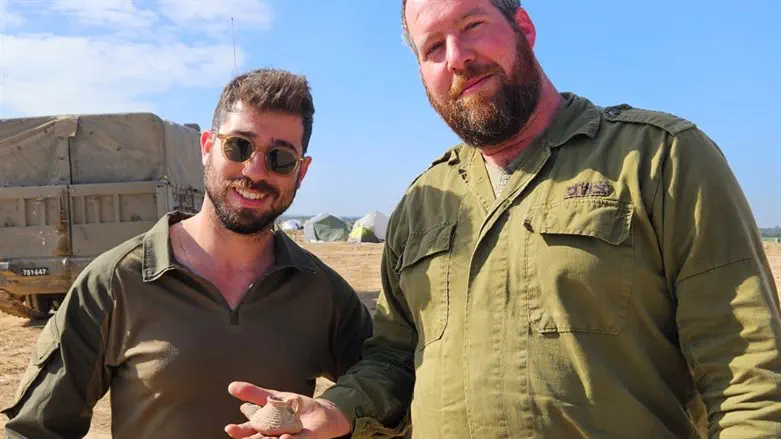
Netanel Malkior and Alon Segev, two reserve soldiers, discovered an ancient lamp in staging grounds near the Gaza border.
The oil lamp, which preserved whole, is estimated to be 1,500 years old, from the Byzantine period.
Following their discovery, the soldiers transferred the lamp to the Israel Antiquities Authority.
"In one of our wanderings in the area, I found a ceramic which was upside-down, and its round shape drew me to it," Netanel said.
"It was covered in mud. I cleaned it off and after I understood what it was, I called the Antiquities Authority."
At the same time, Alon posted a photo of the lamp on a Facebook group, and it drew great interest from readers.
"The post gained momentum, and it received dozens of responses and hundreds of 'likes.' The viewers offered different suggestions regarding the item's purpose. There as well, it was recommended that we call the Antiquities Authority."
Sarah Tal, an archaeologist from the Western Negev district in the Antiquities Authority, said, "This is a lamp from the Byzantine period, about 1,500 years ago, and it is called a 'sandal lamp.' The lamp, which was used for lighting and was common in ancient days, is made in a mold and characteristic of the lowlands and southern Israel."
Tal came to the soldiers, collected the item, and presented them with a certificate from the Antiquities Authority.
"The war has brought us unusual situations, even on the archaeological front," said Eli Askozido, director of the Antiquities Authority.
He added, "The Land of Israel's earth, and especially near the Gaza border, is saturated with history and ancient findings, and the Antiquities Authority works together with the IDF for the purpose of preserving these, even in times of war."
"I am glad that the ancient lamp has brought light even to the soldiers' day, praise the alacrity and the good citizenship, and remind everyone that in a case where you find an ancient item, it is important to leave it in its place and call Antiquities Authority supervisors to the scene, so that the researchers will be able to extract as much information as possible from the find about the site in which it was found."


